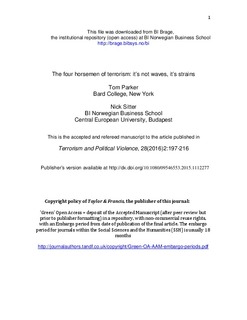| dc.contributor.author | Parker, Tom | |
| dc.contributor.author | Sitter, Nick | |
| dc.date.accessioned | 2016-03-30T12:29:55Z | |
| dc.date.available | 2016-03-30T12:29:55Z | |
| dc.date.issued | 2016 | |
| dc.identifier.citation | Terrorism and Political Violence, 28(2016)2:197-216 | nb_NO |
| dc.identifier.issn | 0954-6553 | |
| dc.identifier.issn | 1556-1836 | |
| dc.identifier.uri | http://hdl.handle.net/11250/2383127 | |
| dc.description | This is the accepted and refereed manuscript to the article | nb_NO |
| dc.description.abstract | David Rapoport’s concept of four waves of terrorism, from anarchist terrorism in the 1880s, through nationalist and Marxist waves in the early and mid-Twentieth Century, to the present religious wave, is one of the most influential concepts in terrorism studies. However, this article argues that thinking about different types of terrorism as strains rather than waves better reflects both the empirical reality and the idea that terrorists learn from and emulate each other. Whereas the notion of waves suggests distinct iterations of terrorist violence driven by successive broad historical trends, the concept of strains and contagion emphasizes how terrorist groups draw on both contemporary and historical lessons in the development of their tactics, strategies, and goals. The authors identify four distinct strains in total – socialist, nationalist, religious, and exclusionist - and contend that it is possible to trace each strain back to a ‘patient zero’ active in the 1850s. | nb_NO |
| dc.language.iso | eng | nb_NO |
| dc.title | The four horsemen of terrorism: it’s not waves, it’s strains | nb_NO |
| dc.type | Journal article | nb_NO |
| dc.type | Peer reviewed | nb_NO |
| dc.source.journal | Terrorism and Political Violence | nb_NO |
| dc.identifier.doi | 10.1080/09546553.2015.1112277 | |
| dc.description.localcode | 1, Forfatterversjon | nb_NO |
